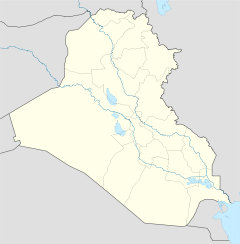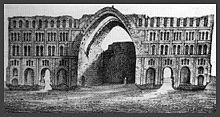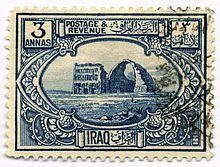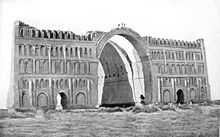- Ctesiphon
-
For other uses, see Ctesiphon (disambiguation).
Coordinates: 33°05′37″N 44°34′50″E / 33.09361°N 44.58056°E Ctesiphon, the imperial capital of the Parthian Arsacids and of the Persian Sassanids, was one of the great cities of ancient Mesopotamia.
The ruins of the city are located on the east bank of the Tigris, across the river from the Hellenistic city of Seleucia. Today, the remains of the city lies in Baghdad Governorate, Iraq, approximately 35 km south of the city of Baghdad.
Location of the city of Ctesiphon, IraqContents
Names
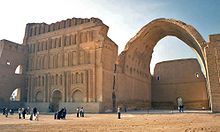 Remains of the Taq-i Kisra in Ctesiphon
Remains of the Taq-i Kisra in Ctesiphon
The Latin name Ctesiphon or Ctesifon (
 /ˈtɛsɨfɒn/) derives from Greek Ktēsiphōn (Κτησιφῶν), a Hellenized form of a local name that has been reconstructed as Tosfōn or Tosbōn.[1] In Iranian sources of the Sassanid period it is attested in Manichean Parthian, in Sassanid Middle Persian and in Christian Sogdian as Pahlavi tyspwn, continuing in New Persian as Tisfun (تيسفون). Syriac sources mention it as ܩܛܝܣܦܘܢ Qṭēsfōn, and in medieval Arabic texts the name is usually Ṭaysafūn (طيسفون) or Qaṭaysfūn (قطيسفون), in Modern Arabic al-Mada'in (المدائن). "According to Yāqūt [...], quoting Ḥamza, the original form was Ṭūsfūn or Tūsfūn, which was arabicized as Ṭaysafūn."[2] The Armenian name of the city was Tizbon (Տիզբոն). Ctesiphon is first mentioned in the Book of Ezra of the Old Testament as Kasfia/Casphia (a derivative of the ethnic name, Cas, and a cognate of Caspian and Qazvin).
/ˈtɛsɨfɒn/) derives from Greek Ktēsiphōn (Κτησιφῶν), a Hellenized form of a local name that has been reconstructed as Tosfōn or Tosbōn.[1] In Iranian sources of the Sassanid period it is attested in Manichean Parthian, in Sassanid Middle Persian and in Christian Sogdian as Pahlavi tyspwn, continuing in New Persian as Tisfun (تيسفون). Syriac sources mention it as ܩܛܝܣܦܘܢ Qṭēsfōn, and in medieval Arabic texts the name is usually Ṭaysafūn (طيسفون) or Qaṭaysfūn (قطيسفون), in Modern Arabic al-Mada'in (المدائن). "According to Yāqūt [...], quoting Ḥamza, the original form was Ṭūsfūn or Tūsfūn, which was arabicized as Ṭaysafūn."[2] The Armenian name of the city was Tizbon (Տիզբոն). Ctesiphon is first mentioned in the Book of Ezra of the Old Testament as Kasfia/Casphia (a derivative of the ethnic name, Cas, and a cognate of Caspian and Qazvin).Location
Ctesiphon is located approximately at Al-Mada'in, 20 miles (32 km) southeast of the modern city of Baghdad, Iraq, along the river Tigris. Ctesiphon measured 30 square kilometers (cf. the 13.7 square kilometers of 4th century imperial Rome). The only visible remains are the great arch Taq-i Kisra or Tagh-e Kasra located in what is now the Iraqi town of Salman Pak.
History
Ctesiphon rose to prominence during the Parthian Empire in the 1st century BC, and was the seat of government for most of its rulers. The city was located near Seleucia, the Hellenistic capital. Strabo abundantly describes its foundation:
In ancient times Babylon was the metropolis of Assyria; but now Seleuceia is the metropolis, I mean the Seleuceia on the Tigris, as it is called. Near by is situated a village called Ctesiphon, a large village. This village the kings of the Parthians were wont to make their winter residence, thus sparing the Seleuceians, in order that the Seleuceians might not be oppressed by having the Scythian folk or soldiery quartered amongst them. Because of the Parthian power, therefore, Ctesiphon is a city rather than a village; its size is such that it lodges a great number of people, and it has been equipped with buildings by the Parthians themselves; and it has been provided by the Parthians with wares for sale and with the arts that are pleasing to the Parthians; for the Parthian kings are accustomed to spend the winter there because of the salubrity of the air, but they summer at Ecbatana and in Hyrcania because of the prevalence of their ancient renown.[3]
Because of its importance, Ctesiphon was a major military objective for the leaders of the Roman Empire in their eastern wars. The city was captured by Rome five times in its history – three times in the 2nd century alone. The emperor Trajan captured Ctesiphon in 116, but his successor, Hadrian, decided to willingly return Ctesiphon in 117 as part of a peace settlement. The Roman general Avidius Cassius captured Ctesiphon in 164 during another Parthian war, but abandoned it when peace was concluded. In 197, the emperor Septimius Severus sacked Ctesiphon and carried off thousands of its inhabitants, whom he sold into slavery.
Late in the 3rd century, after the Parthians had been supplanted by the Sassanids, the city again became a source of conflict with Rome. In 283, emperor Carus sacked the city uncontested during a period of civil upheaval. In 295, emperor Galerius was defeated outside the city. However, he returned a year later with a vengeance and won a victory which ended in the fifth and final capture of the city by the Romans in 299. He returned it to the Persian king Narses in exchange for Armenia and western Mesopotamia. In c.325 and again in 410, the city, or the Greek colony directly across the river, was the site of church councils for the Church of the East.
Emperor Julian was killed following a battle outside of the city walls, in 363, during his war against Shapur II. Finally, in 627, the Byzantine Emperor Heraclius surrounded the city, the capital of the Sassanid Empire, leaving it after the Persians accepted his peace terms.
Ctesiphon fell to the Muslims during the Islamic conquest of Persia in 637 under the military command of Sa'ad ibn Abi Waqqas during the caliphate of Umar. However, the general population was not harmed but the palaces and their archives were burned. Still, as political and economic fortune had passed elsewhere, the city went into a rapid decline, especially after the founding of the Abbasid capital at Baghdad in the 8th century, and soon became a ghost town. It is believed to be the basis for the city of Isbanir in the Thousand and One Nights.
The ruins of Ctesiphon were the site of a major battle of World War I in November 1915. The Ottoman Empire defeated troops of Britain attempting to capture Baghdad, and drove them back some 40 miles (64 km) before trapping the British force and compelling it to surrender.
Palaces of Ctesiphon
Main article: Taq-i KisraSee also: Sassanid architectureThe splendor of the imperial palace complex at Ctesiphon, to include Khosrau II's palace (Shâhigân-ǐ Sepid = the white palace, now almost totally ruined) and the great arch Taq-i Kisra, remain legendary. The Throne room—presumably under or behind the arch—was more than 36 m (110 ft) high. The massive barrel vault covered an area 24 m (80 ft) wide by 50 m (160 ft) long, and was the largest vault ever constructed in Persia. It is still "the largest unreinforced brick vault in the world."[4]
Archaeology
A German Oriental Society and University of Pennsylvania team led by Oscar Reuther excavated at Ctesiphon in 1928–29 and 1931–32, mainly at Qasr bint al-Qadi on the western part of the site.[5][6][7][8]
In the late 1960s and early 1970s, an Italian team from the University of Turin directed by A. Invernizzi and G. Gullini worked at the site, mainly doing restoration at the palace of Khosraw II.[9][10][11][12][13][14]
See also
Notes
- ^ E.J. Brill's First Encyclopaedia of Islam 1913–1936, Vol. 2 (Brill, 1987: ISBN 9004082654), p. 75.
- ^ Kröger, Jens (1993), "Ctesiphon", Encyclopedia Iranica, 6, Costa Mesa: Mazda, http://www.iranica.com/newsite/articles/v6f4/v6f4a030.html
- ^ Strabo XVI, 1, 16
- ^ Oates, Joan, Babylon, Thames and Hudson 1996, 48
- ^ K. Schippmann, Ktesiphon-Expedition im Winter 1928/29, Grundzüge der parthischen Geschichte, Darmstadt, 1980
- ^ E. Meyer, Seleukia und Ktesiphon, Mitteilungen der Deutschen Orient-Gesellschaft zu Berlin, vol. 67, pp. 1–26, 1929
- ^ O. Reuther, The German Excavations at Ctesiphon, Antiquity, vol. 3, no. 12, pp. 434–451, 1929
- ^ J Upton, The Expedition to Ctesiphon 1931–1932, Bulletin of the Metropolitan Museum of Art, vol. 27, pp. 188–197, 1932
- ^ G. Gullini and A. Invernizzi, First Preliminary Report of Excavations at Seleucia and Ctesiphon. Season 1964, Mesopotamia, vol. I, pp. 1–88, 1966
- ^ G. Gullini and A. Invernizzi, Second Preliminary Report of Excavations at Seleucia and Ctesiphon. Season 1965, Mesopotamia, vol. 2, 1967
- ^ G. Gullini and A. Invernizzi, Third Preliminary Report of Excavations at Seleucia and Ctesiphon. Season 1966, Mesopotamia, vol. 3–4, 1968–69
- ^ G. Gullini and A. Invernizzi, Fifth Preliminary Report of Excavations at Seleucia and Ctesiphon. Season 1969, Mesopotamia, vol. 5–6, 1960–71
- ^ G. Gullini and A. Invernizzi, Sixth Preliminary Report of Excavations at Seleucia and Ctesiphon. Seasons 1972/74, Mesopotamia, vol. 5–6, 1973–74
- ^ G. Gullini and A. Invernizzi, Seventh Preliminary Report of Excavations at Seleucia and Ctesiphon. Seasons 1975/76, Mesopotamia, vol. 7, 1977
References
- M. Streck, Die alte Landschaft Babylonien nach den arabischen Geographen, 2 vols. (Leiden, 1900–1901).
- M. Streck, "Seleucia und Ktesiphon," Der Alte Orient, 16 (1917), 1–64.
- A. Invernizzi, "Ten Years Research in the al-Madain Area, Seleucia and Ctesiphon," Sumer, 32, (1976), 167–175.
- Luise Abramowski, "Der Bischof von Seleukia-Ktesiphon als Katholikos und Patriarch der Kirche des Ostens," in Dmitrij Bumazhnov u. Hans R. Seeliger (hg), Syrien im 1.-7. Jahrhundert nach Christus. Akten der 1. Tübinger Tagung zum Christlichen Orient (15.-16. Juni 2007). (Tübingen, Mohr Siebeck, 2011) (Studien und Texte zu Antike und Christentum / Studies and Texts in Antiquity and Christianity, 62),
External links
Categories:- Archaeological sites in Iraq
- Persian archeological cities
- History of Iran
- Former populated places in Iraq
- Populated places along the Silk Road
Wikimedia Foundation. 2010.

